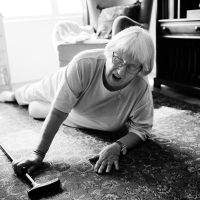
Key messages
– Cognitive behavioural therapy (CBT) with and without exercise probably reduces fear of falling in older people living in the community, when measured once treatment has ended. Improvements may be sustained during the first six months after treatment finished, and probably last beyond six months.
– As a consequence of these interventions, people may be less likely to avoid activities after treatment and their level of depression may be reduced.
– It is unclear if the frequency of falls is reduced following treatment.
– We do not know if there are any adverse effects (harms) caused by CBT with and without exercise for reducing fear of falling, as none of the studies measured this as one of their outcomes. We need more studies looking at adverse effects.
What is fear of falling?
Fear of falling is a lasting concern about falling that leads to a person avoiding activities that he/she remains capable of performing. Fear of falling is common among older adults. They may be warned by healthcare professionals, family, and friends of the dangers of falls, as well have witnessed directly or indirectly the consequences of a fall. This is significant as up to 34% of older adults fall each year, with 5% experiencing bone fractures. Furthermore, they may recognise that their body is not as strong as it was when they were younger, adding to concern that they may not be able to protect themselves from a fall, and must, therefore, take preventive measures to avoid falling. People with fear of falling can experience physical, psychological, and social consequences. Treating fear of falling is therefore important to reduce dysfunctional cognitions and behaviours leading to these consequences.
How is the condition treated?
There are several treatment approaches: cognitive behavioural therapy (CBT) (a talking therapy that helps change thoughts and behaviour), exercise (a planned, structured, and repetitive physical activity to help keep the body healthy), or a combination of both. These treatments are usually given in group settings by trained therapists.
What did we want to find out?
We wanted to find out if CBT with and without exercise in older adults living in the community (who live in places without additional support, such as assisted living centres) were better than usual care or dummy treatments in reducing fear of falling. We also wanted to see how CBT with and without exercise affected activity avoidance, falls, and depression, or if it caused any harm.
What did we do?
We searched several electronic databases and consulted experts for studies that compared interventions to reduce fear of falling using CBT alone and CBT with exercise.
We combined and summarised the results across the studies. We rated our confidence in the evidence based on factors such as study design, methods, and numbers of participants.
What did we find?
We found 12 relevant studies, of which 11 studies were included for statistical analyses with a total of 2383 people, with a mean age varying from 73 to 83 years. The therapy (CBT or dummy treatment) was given at a frequency from three times per week to once per month, for eight to 48 weeks. Added up, the treatments lasted between six and 156 hours. Most interventions were given in groups of between five and 10 participants, and in one study up to 25. The primary aim of 10 studies was to reduce fear of falling.
Main results
We found that CBT with and without exercise interventions probably reduces fear of falling in older people living in the community once treatment has ended. Improvements may be sustained during the first six months after treatment finished, and probably last beyond six months. Additionally, we found that people may be less likely to avoid activities, and may reduce their level of depression. It remains unclear if the frequency of falls improves after treatment.
What are the limitations of the evidence?
Our confidence in the evidence was limited because the results may have been influenced by the participants in the studies knowing which treatment they received and the studies used different ways of delivering the interventions.
To improve our certainty of the evidence, we would need more studies, with more similarity in how they treated and measured fear of falling.
How up to date is this evidence?
This evidence is up to date to 11 January 2023.

